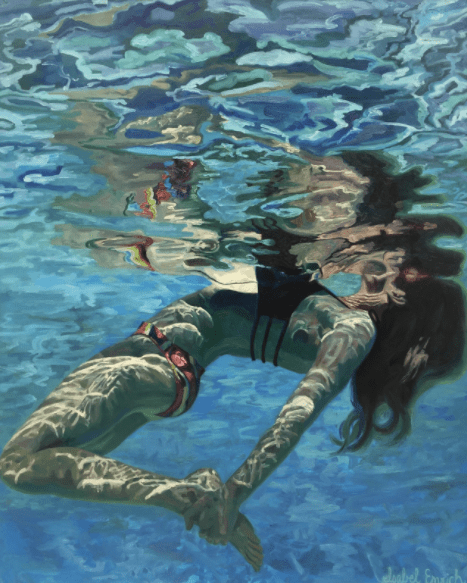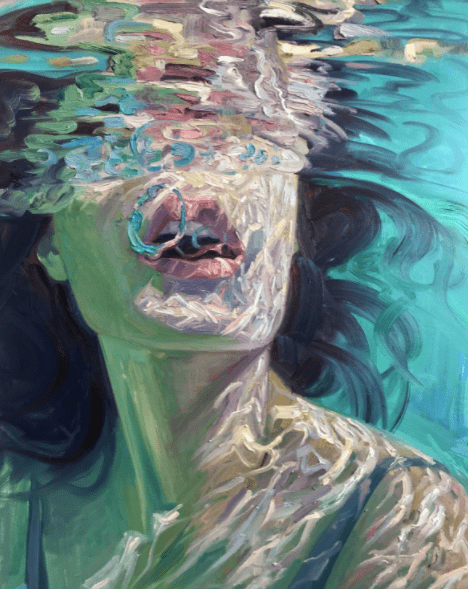Being Under
By Nishka Narang
When you’re scuba diving, you’re 30 feet underwater and completely reliant on one tank of compressed air. Most people start dives with a pressure of 3000 psi in their tank. As you breathe in that air, the pressure in the tank decreases. Once it goes down to 1500 psi, it’s time to end the dive. You need to save enough air to slowly make your way back to the surface – slowly enough that you can equalize the pressure in your lungs so they don’t pop.
I went diving yesterday. It was just a refresher, so it was in a community pool. I practiced strapping the tank to my back, checking my pressure gauge, and using my backup regulator. I laughed at my brother learning the hand signal for “out of air” – a hectic cutting motion across your neck.
Since I wear contact lenses, I have to keep my eyes closed underwater. I practiced what I would do if my scuba goggles got knocked off my head. My instructor told me to take off my goggles, close my eyes, keep breathing for a minute, and then find and wear my goggles. I messed up right away. I closed my eyes and stopped breathing. And then I chaotically scrambled to just hurry and wear my goggles again so I could see.
But what was the problem? I was in a quiet pool, next to my older brother, and was able to breathe through my regulator. If I wanted to breach the surface and breathe fresh air, all I had to do was straighten my legs. The only thing was that I couldn’t see. I was underwater and I couldn’t see a thing. Why was that so terrible for me? They asked me what happened and told me to breathe. “Breathing will calm you,” my brother said. So I tried it again. Taking deep breaths, I squeezed my eyes shut and pulled my goggles off, feeling the slight waves of the water rock me back and forth for a bit. It was peaceful.
Isabel Emrich, born in 1993 in Irvine, California, is an artist that grew up near the ocean. When she was little, she “would swim down as far as [she] could go and open [her] eyes to look around” (20). Regarding one of her first underwater paintings, Endless Color (2015), Isabel Emrich says she likes “the juxtaposition of the ocean in the way that it is both very chaotic and peaceful” (2).

Isabel Emrich, Endless Color, 2015, Oil on Panel, 60″ x 48”
I also struggled with equalizing the pressure in my body. As I followed the instructor to the deeper side of the pool, my ears felt tight. Unpopped, like you might’ve felt during a plane landing. When you try to equalize, you’re supposed to hold your breath and pinch your nose. How am I expected to hold my breath so I don’t literally pop and keep breathing to calm myself down?
And after I got through that, I practiced making a controlled emergency ascent. This is needed when you don’t have enough air to slowly make your way to the surface. When going up fast, you need to steadily breathe out the air in your lungs so that they don’t pop from the pressure. I didn’t have enough air to last the whole ascent, so I let myself cheat. An extra breath of air from my tank halfway through helped me stay calm and focused. Helped me feel like I wasn’t about to die.

Isabel Emrich, Speak Up, 2018, Oil on Canvas, 36″ x 24”
Emrich had a near-death experience at age 14. Big waves “kept [her] under the surface for a long period of time” and she thought she was going to die. She prayed to God and was eventually “able to shoot up to the surface for a gasp of air” (20-21).
Before we got out of the water, my instructor told us to swim around for a bit and enjoy ourselves. I practiced my equalizing once more and decided to sit at the bottom of the deep end of the pool, watching my brother as he swam around me. I let myself feel his movement through the water and watched the dancing reflections of light on him that reminded me of Isabel Emrich’s paintings. My brother and I completed our refresher course after three hours of practicing life-depending skills. I took off the equipment in steps: unstrapping the tank, unbuckling the vest, removing the weights, slipping off the fins, and peeling off the wetsuit. I went to shower.
Emrich’s thesis is titled “Total Immersion.” She discusses her connection to being underwater, her anxiety and breathing, and her inspirations for her art. She believes in staying in the moment and being totally immersed in living. When I thought of her and her work at the bottom of that pool, I felt like I understood the immersion of her underwater paintings. The feeling of floating and of light. The chaos of the surface above and the peace of being under.
Works Cited
Emrich, Isabel. Total Immersion. May 2019. Laguna College of Art & Design, Master of Fine Arts Thesis, Emrich_Total Immersion_2019_Pages Version.pages 2.
Isabel Emrich. Squarespace, www.isabelemrich.com/. Accessed 30 July 2021.